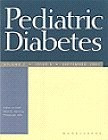Tapia G, Cinek O, Rasmussen T, Grinde B, Stene LC, Rønningen KS. Pediatr Diabetes. 2011 Feb;12(1):58–62. IF: 2.628

The role of infections in pathogenesis of autoimmune diabetes (type I diabetes, T1D) is worldwide studied. As mentioned in ‘Publikacni okenko’ just before, Ondrej Cinek, MD from Laboratory of Molecular Genetics, Department of Paediatrics, in collaboration with his colleagues from Oslo, Norway, works on the topic: viral infections detected in stool samples as a potential risk for T1D development. One of their common publications is the above mentioned, where association between parechovirus and development of pancreatic islets autoantibodies was investigated.
The first author of this publication is German Tapia, PhD, postgraduate student from University in Oslo, Norway, regular visitor in the Ondrej Cinek's laboratory. We applied him for some words about results of their work on the topics ‘viral infection and T1D’:
Our research group has been investigating the relationship between viral infection and type 1 diabetes for a long time. Viral infections are one of many potential environmental factors for type 1 diabetes; I and Dr. Cinek have worked mostly with viruses while other researchers in our group have looked at other factors such as bacteria, parasites and diet. Our latest studies have been on viral infections in the gastrointestinal system in young children who developed type 1 diabetes and healthy children. By collecting stool samples from 3 to 35 months of age we could investigate any viruses present in the gastrointestinal system. The focus of our investigation was in the beginning the human enteroviruses and Ljungan virus, two viruses which earlier studies have put forth as possible candidates. However, we did not find any significant difference between children who developed type 1 diabetes and children who did not. In addition we investigated a related virus, human parechovirus, and surprisingly found a difference between the groups. Children who developed type 1 diabetes had more human parechovirus infections in the three months just before they developed islet autoantibodies (which are a sign that they have developed islet autoimmunity, which is the first step to type 1 diabetes). This observation will be investigated further. In addition we have also investigated other viruses in our material, among them cytomegalovirus, adenovirus and anelloviruses, but have not found any significant differences between children who developed islet autoantibodies and children who did not. All these viruses, including the enteroviruses and parechoviruses, are common in young children and infect most people at a young age without causing any disease. Many viruses are ubiquitous and seldom cause disease; the reasons for this are not well known but it does make it possible that a ‘common’ virus might be involved in the development of type 1 diabetes. We hope, of course, to find any such virus. To this end we are currently working on extending the number of children tested in our study and to test blood samples to further investigate viral infections in young children who develop type 1 diabetes. In addition, we will also be studying infections and antibodies in mothers during pregnancy and birth to investigate how this affects their children risk for developing type 1 diabetes.
Link to a related article by German Tapia, published in Publikacni okenko in past.
-az-